By Jeffrey A. Rendall, Photos By Jeffrey A. Rendall
DANIELS, WV – At Glade Springs Resort, George Cobb must’ve thought he was in Texas.
Vernacular included, there ain’t much that’s small in the Lone Star State. Big ranches, big steaks, big politics, big sports, big talk – when you’re thinking Texas, better grab for the large sizes.
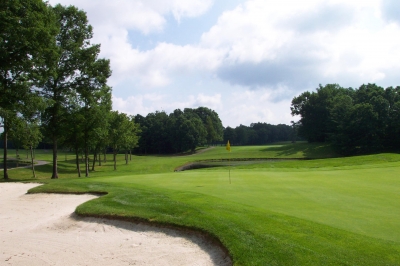 |
| Looking from behind the 16th green -- you'll already see that there're big greens and big bunkers on the Cobb Course. |
The same ‘big is better’ philosophy holds true for Glade Springs Resort’s Cobb Course (designed by its namesake, George Cobb, and opened in 1974), though the layout’s physical location in West Virginia is well over a thousand miles away from the nearest longhorn steer in Texas.
That didn’t seem to matter to Cobb, as he built Texas-sized greens and bunkers on the Cobb Course, probably the biggest we’ve ever seen. Royal New Kent in Virginia has some super-sized features of its own, but not as consistently gargantuan throughout the golf course as does Cobb. Here, just because you’re on the green in regulation doesn’t assure you a par – or maybe even a bogey. Yes, they’re that big at Glade Springs.
“We’ve got 225,000 square feet of greens space,” said Keith Honaker, Director of Golf & Grounds Maintenance for the resort. “One of our chemical guys who works the whole country said we have the third biggest greens in the United States (two courses in California apparently took the Texas theme to an even greater extreme). I don’t know if that’s true, but he says we have the biggest greens of any course east of the Mississippi, anyway.”
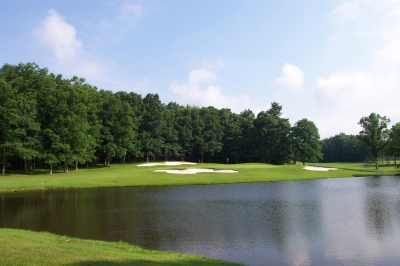 |
| Tom Clark moved the tees back on the par four 11th hole, so now you can use a driver off the tee and not worry about contending with this lake. |
At 225K, employing a little elementary math, it comes to 12,500 square feet per green on average. In this business a 10,000 square foot green is considered Godzilla proportioned, so that’ll provide some perspective on the situation at the Cobb Course.
Further, it’s not like they’re just huge, round, flat surfaces, either. There are plateaus, valleys and tongues to tuck pins. You’ve seen professionals having to use their chipping skills on putting greens before, but thought you’d never have to use them yourself – on the Cobb Course, maybe you should reconsider that assessment.
The greens are so large that Honaker says they can’t even use walking mowers to trim them. How many riding mowers have you seen on a putting green before? There’s always a first time, and the Cobb Course blazes the trail.
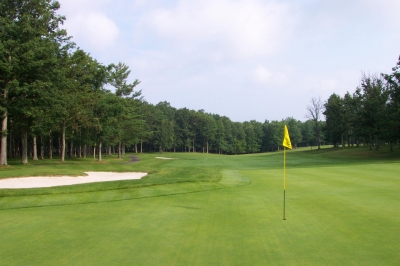 |
| The green is over 80 yards deep on the par four 8th hole -- many opportunities to test your lag putting skills. |
The putting surfaces aren’t the only biggie sized offerings at Glade Springs. The bunkers guarding the greens are equally impressive in scale. Hopefully you’ll have practiced all those Dave Pelz sand shots prior to visiting the Cobb Course – because there’ll be challenges of all different elevations and lengths if you get in them.
But don’t be so ‘size’ intimidated that you stay away completely, however. Just because the greens and bunkers are large doesn’t mean the other things are comparably small on this layout. There’s also a disproportionately big amount of room to play the ball on the Cobb Course. In the style of a seventies resort course, you can hit the ball practically anywhere on several of the holes (especially on the front nine) and it’s still playable, assuming you can locate it in the dense rough. The hardwoods on the entire track are fully grown and mature, but the worst you’ll face is a chip back to the fairway if you find yourself in amongst ‘em.
On our visit to Glade Springs, we played the Cobb Course the day after taking on the Resort’s new headlining gem, Stonehaven. Usually, when you experience something like Stonehaven, then play the ‘other’ course, you’re in for a let-down. Surprisingly, it wasn’t that way at all.
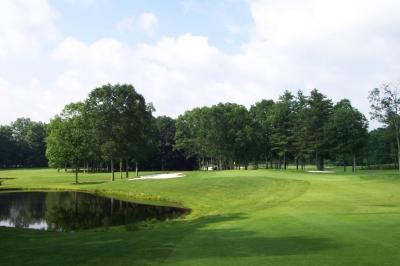 |
| The Cobb Course's back nine offers many opportunities to test your shot-making. Here, the par four 14th hole -- hit a draw into the green. |
Honaker says that’s what he’s hearing, too: “Most people who come here have probably heard about Stonehaven, and they’re looking forward to seeing it – and they’ll play the Cobb Course because it’s the ‘other’ golf course here. But I can’t tell you how many times I’ve heard that they liked Cobb just as much. They’re two truly different golf courses, but they’ve each got charm in their own way. And they’re both memorable.”
That’s no exaggeration. Honaker said they used to bill Cobb as a mountain course, seeing as it’s got 200 feet of elevation change from low point to high point. It’s funny, but you’d never realize the ups and downs as you’re moving along – there just aren’t the dramatic drops or climbs that you’re seeing on Stonehaven. And don’t even think about cart-path switchbacks over here (like on Stonehaven’s 16th hole). It’s a gentle rolling ride on Cobb the whole way – you can leave your Dramamine and air sickness bag at home.
The difference between the two courses is in the nature of the terrain. When Cobb was built, the original owners gave George Cobb first choice of the land to work with, and he selected the best ground for the golf course, prior to the homes being built. Stonehaven is a 21st century creation and had to fit amongst a housing development, on much rougher land. Tom Clark of Ault, Clark & Associates did a masterful job of routing Stonehaven, so you’ve got the elevation changes, yet still have no trouble getting around it.
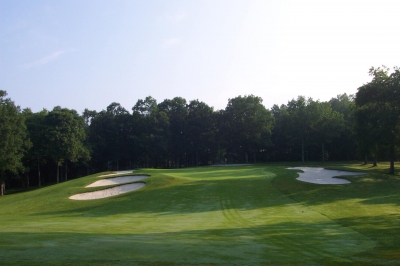 |
| Morning shadows obscure the par three 3rd hole -- but even at 247 yards, you'll see there's a big target to shoot at. |
As Clark was finishing Stonehaven, he came across to the Cobb side to do some upgrade work as well. He was impressed by what he saw, and the changes he made brought the course up to more contemporary standards for length and playability.
“I think the Cobb Course is one of George Cobb’s better golf courses,” Clark said. “When we got the Stonehaven job, I checked it out to see what the ‘competition’ was like, and I thought, ‘well, not bad.’ I couldn’t believe the sizes of those greens – some of them are like four greens in one. The bunkers are huge too. It’s just a big, big golf course.”
But it also needed some work. Thirty years is a long time in the life of a golf layout, and no doubt things had changed since Cobb finished up the course all those years before. Clark said Glade Springs’ owner, Bill Bright, wanted to put some money into sprucing up the Cobb Course and its facilities as well.
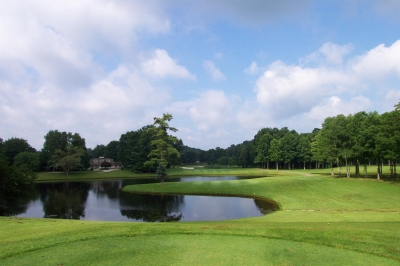 |
| It's about 200 yards of water carry off the tee of the par four 16th hole -- and there's not much room to miss side-to-side, either. |
“First we attacked the practice facility. They’d only had a tiny little tee at one end, so we expanded both sides of it, looking for more size and rebuilt the entire tee complex, added target greens and target fairways and drainage. It’s still not completely done, but should be very nice once it’s complete,” Clark said.
Then they tackled the course itself. Clark said they went around hole by hole and re-outlined a lot of the fairways because the lines had changed dramatically over the years. They took out some old railroad ties that had bordered some of the cart paths. The resort had previously redone the bunkers itself without altering the looks dramatically, but the Clark group decided to add a few more fairway bunkers to define tee shot landing areas.
“We did a lot of little things to make individual golf holes better, like adding chipping areas around a few of the greens. We added about 300 yards in length to stretch it out over 7,100 yards – and actually shortened it a bit for the ladies – so we ended up building quite a few new tees,” Clark added.
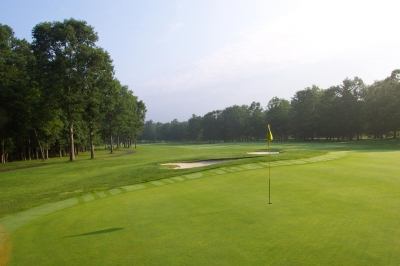 |
| The 520-yard, par five 2nd hole seems like it'd be an easy birdie, but you'll need accuracy to give yourself a realistic chance at it. |
The changes are relatively seamless to a person who’d never seen the course before, but you can tell Clark had added some length to holes like number nine (the new tee is way back there), which now goes at 475 yards to the back tee player. Miss the fairway on that one, and you’re hoping to one-putt for par.
Other than the ‘bigness’ of the course, there’s really nothing else on the Cobb Course to intimidate you – there’s nothing hidden or tricky, and I can’t think of a single blind shot on the entire layout. The putting surfaces may be huge, but they’re all open in front, which certainly brings chip and roll into the equation.
As you’d expect with the sizes of the greens, knowing the pin position is critical. Numbers six and eight’s greens are over eighty yards deep – that’s a heck of a difference between front and back. Nothing quite like trying to decide between an eight-iron and a four-iron for your approach shot.
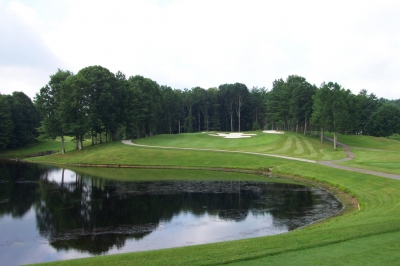 |
| The 17th hole is the most difficult par three on the course, because it's uphill, often into the wind and has large bunkers protecting it. |
The course plays longer than its listed yardage because of the greens’ size, but also the rough. There’s more than enough short grass to play to, but if you miss the fairway you’ll give up fifty yards of roll – then you’ll have to hack it out of that stuff to advance it. Granted, our visit included playing after a rain storm (which made the rough like wet cement), but this course requires careful club selection from the tee box to keep it on the short mowed ground.
The two nines also play very differently, in one respect. The front nine is slightly longer, but only has one water hazard, on the par five fifth hole – and that’s only going to come into play if you’re in the rough off the tee. In contrast, you’ll see water on five of the holes on the back nine, including the par four sixteenth hole, which features a carry over a lake off the tee and then again into the green.
The par three seventeenth hole is one of the toughest one-shotters you’re going to see. The card says it’s ‘only’ 200 yards from the back tees, but it’s uphill and into the prevailing wind most of the time, according to Honaker. The odd shaped green is virtually surrounded by sand. This hole’s a real test.
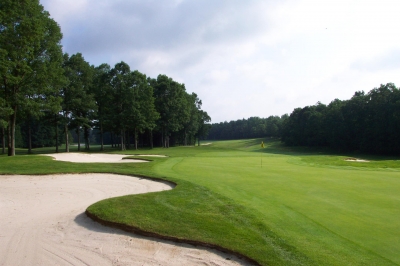 |
| The 549-yard, par five 18th hole is the Cobb Course's number two handicap hole, and deserves the designation. |
Honaker says it’s in the short-range plans to finish off the range and establish a golf academy at Glade Springs. There, you’ll no doubt be able to sharpen your skills for use out on the courses – and hopefully, it’ll turn that Texas-sized slice into a real nice draw in the process.
You can only dream… and at the Cobb Course, dreaming big is the only way to do it.
Glade Springs Resort – Golf, and Much More
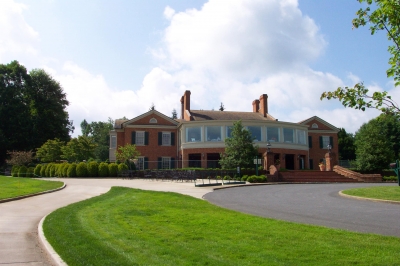 |
| Glade Springs' clubouse offers a full range of amenities, including a nice restaurant. |
Family-friendly Glade Springs Resort is an outdoor oriented destination, with a multitude of activities to choose from before, after, or even instead of golf (okay, maybe not instead of). The resort offers a full-service equestrian center, a pool, Spa, tennis courts, hiking trails and horseback riding trails, as well as two restaurants for your culinary needs.
For the outdoorsman in you, there’s fly-fishing, casting classes, whitewater rafting, and target shooting. Snow skiing is nearby for the winter months. The golf courses remain open year-round, snow cover permitting.
Sleeping accommodations range from one bedroom suites to six bedroom lodges – bring your group of up to forty, and you’ll find space for them. Consult the website at http://www.gladesprings.com for more details, as well as contact and booking information.
Glade Springs Resort offers well accented accommodations and facilities, perhaps a notch below The Greenbrier and The Homestead – but a stay there won’t come nearly as dear, either.
Note: Check the links below for a review of Stonehaven, as well as other golf offerings nearby.
Details:
The Cobb Course at Glade Springs Resort
Phone: (866) 704-7031; (304) 763-2000
FAX: (304) 763-3398
Website: www.gladesprings.com?NCK=golfthemidatlantic
Course Designer: George Cobb
Renovations By: Tom Clark of Ault, Clark & Associates
Glade Springs’ Director of Golf & Grounds Maintenance: Keith Honaker
Tees/Yardage/Slope/Rating
Black 7121 143/74.8
Blue 6611 137/72.2
White 6134 133/70.6
Yellow 5431 115/66.5 (L) 129/72.2
Red 4962 126/69.6
Rates:
Stonehaven
Weekday $75.00 plus tax
Weekend $85.00 plus tax
Member Guest $55.12
Resort Guest $63.81
Cooper Land Development Guest $55.12
Cobb Course
Weekday $69.00 plus tax
Weekend $79.00 plus tax
Member Guest $53.00
Resort Guest $62.54
The Cobb Course is very walker friendly, and you can walk it anytime – in fact, it’s recommended.
Additional fee for range privileges.
| Related Links | Comments on this article? | |
|
Maryland National Golf Club Hollow Creek Golf Club Rocky Gap Resort PB Dye Golf Club in Ijamsville Whiskey Creek Golf Club |
E-mail Jeff Rendall, Editor: jrendall@golftheunitedstates.com |












